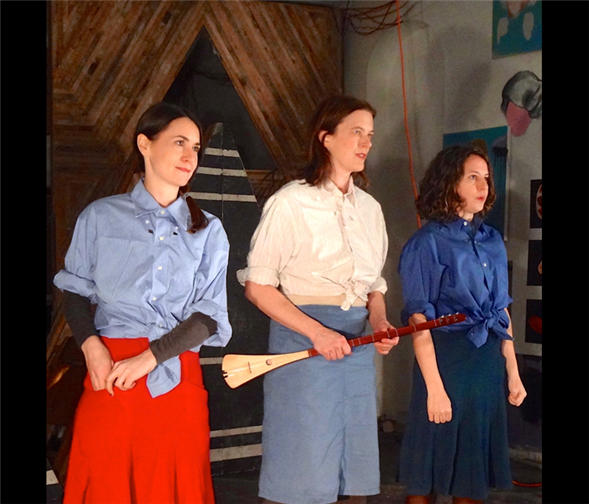Translate Page

Cara Scarmack's Before You Get Too Far Afield, which runs Aug 13 – 23 at JACK in Clinton Hill, is not your everyday play about the every day.
For starters it's an operetta in three parts. Time works differently in the show than we might expect. Three female actors perform no fewer than twelve characters and play a variety of instruments.
Plus, the piece was influenced by the Futurists and Ezra Pound. The Futurists were known for manifestos that rejected the past, expressed a love of war and machinery, and called for a new aesthetic language. Ezra Pound's Cantos, on the other hand, deal with the heartbreaking repercussions of WWI. While these two sources may seem contradictory, Scarmack says, "I was interested in how the Cantos don't cohere in any way. And I wanted to not be afraid to write something that didn't evidently cohere while borrowing influences from the Futurists because I love their language and how they shake up complacency."
Tellingly, the show's subtitle is "A broken play for a broken world," and the structure is as thorny as a raspberry patch. To wit: Using direct address, in order to get audiences thinking about the world we live in, the prologue starts at a bus stop where we encounter such characters as a sun beam, a drowned moth, and a gnat, who sing and speak about their lives. They may seem small and mundane, but that's on purpose. "We want to bring these snippets of life to the audience's attention," Scarmack says.
The second section, called "The Men Middle Bit," behaves like a more conventional drama, where characters have names and relationships to each other. "The three female actors put on men's suits," says Scarmack. "They bicker, and they talk a lot about a hypothetical war." But as the men have difficulty connecting to one another, they change back into their forms from the prologue. Audiences learn they want to go on a journey and lose themselves or, as Scarmack says, "We find out that men are just as human as anyone."
When the actors revert to their prologue selves, they ask the audience to think about the last time they took a big journey. "We want people to think about an earthquake in their lives that was for the good, and so we philosophically talk about how we imprison ourselves and about how we can escape the prisons we place on ourselves," says Scarmack. Then she adds, "It's a big interruption when this happens in the play, and in some ways the play structure is broken. It doesn't follow its own rules."
In the final segment, "The Daughters of Discontent," the actors portray the daughters of the men who were at war in the previous section, and this last part is entirely sung through. "We hear how the descendants of these men are grappling with what they have been handed," Scarmack says. "It's the most poetic and least narrative driven of the three sections."
The impulse to make the last section full of music was a self-imposed artistic challenge for Scarmack, who often writes 10-15 second folk songs for her other plays, but it also came out of a deeper dramaturgical necessity.
"We unload a lot into the audience's lap," Scarmack says. "They witness a play without knowing what it is. The play keeps changing, but finally in the last part it's all singing. That opens up the spectator's guts in a way that is emotional. Music does something that spoken text can't do quite as immediately."
She hopes the tunes, written in collaboration with the actors, will soothe audiences and allow them to breathe. "Even if there isn't a lot of comprehension there can be emotional possibility," she says. "The songs are a kind of thank you for coming on this broken journey with us."
Then she adds brightly, "The third section is also the shortest. I feel like brevity is always appreciated in the theatre."
---
Eliza Bent regularly writes about Brooklyn theatre for TDF Stages
Top photo, featuring the cast, by Cara Scarmack. Second photo by Ken Mah.